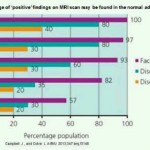Most low back pain is due to minor sprains which are very painful but should heal completely and allow you return to full pain free movement. However in some cases the back can become very sensitised with the nerves remaining on high alert. In these cases the nerves send signals of pain even when the initial injury has healed or there is no damage to the back. This can be very frustrating for people as it can often be difficult to pinpoint this pain. In this way Long term Back pain is often not due to damage but to sensitivity of the structures. Similar to sensitivity in your ankle after a sprain. It is necessary to retrain your back that movements are normal and comfortable.
Changes in your back, seen on an MRI scan, are quite normal in many cases just as greying hair is normal as we age. Studies have shown that even people who have never had back pain can have some changes on their MRI scans or X-rays.
Your back is a strong structure built to move. It may be necessary to modify the way you move to allow optimal use of the back and surrounding muscles. In time this movement will serve to strengthen your back.
As you can see many people will have “changes” on MRI – some will have, others will not. So even if your scan has shown some of these it does not necessarily mean you will experience pain. treating the muscles and surrounding structures can have a huge impact on pain. So changes on MRI is not a sentence for pain.
Did you know that stress, lack of sleep, muscle tension or worry can impact on back pain. Studies have shown that enough sleep, exercise, healthy diet and reducing stress can reduce even long standing low back pain.
It’s important to gradually increase your exercise over a matter of weeks eg 10% a week. Increasing the time spent exercising. Some discomfort when you return to exercise is normal just as it would be when returning after an ankle sprain.


